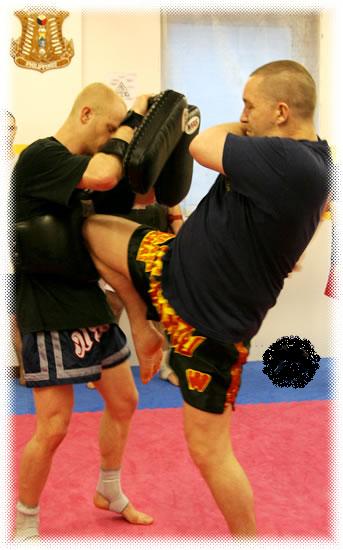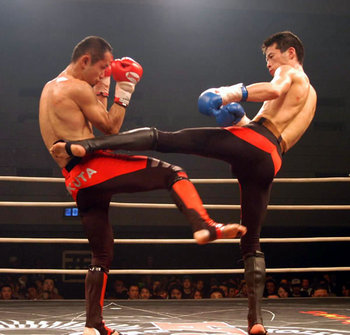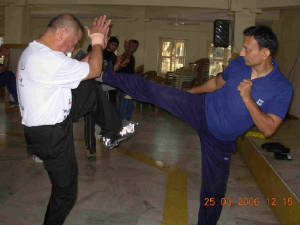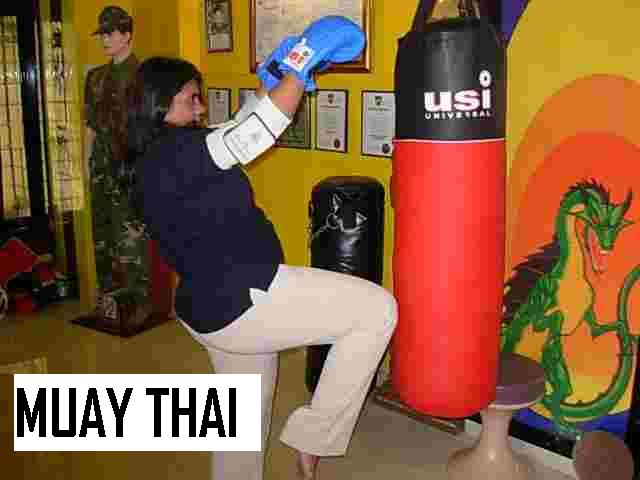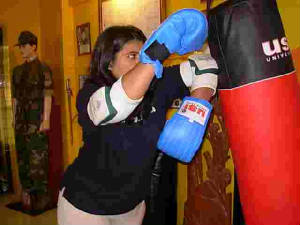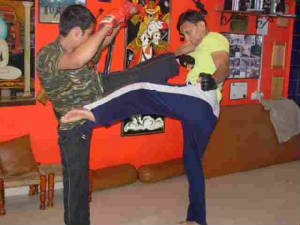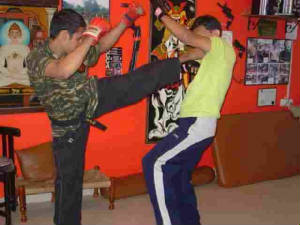

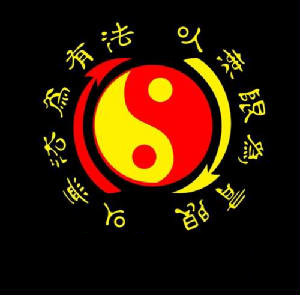
Muay Thai - Kick Boxing
Muay Thai is Thailands national sport. Traditional Muay Thai practiced today uses kicks and punches in a ring with gloves similar to those used in Western Boxing. Muay Thai is referred to as "The Science of Eight Limbs", as the hands, shins, elbows and knees are all used extensively in this art. A master practitioner of Muay Thai thus has the ability to execute strikes using eight "points of contact," as opposed to "two points" (fists) in Western boxing and "four points" (fists, feet) used in the primarily sport-oriented martial arts
Formal Muay Thai techniques are divided into two groups: Mae Mai or major techniques and Luk Mai or minor techniques.
The basic offensive techniques in Muay Thai use punching fists, elbows, shins and knees to strike the opponent. To bind the opponent for both offensive and defensive purposes, small amounts of grappling and clinch is used. Almost all techniques in Muay Thai use the entire body movement, rotating the hip with each kick, punch, and block. The rotation of the hips in Muay Thai techniques, is what sets Muay Thai apart from other styles of martial arts.
Punching techniques (chok)
The Punch techniques in Muay Thai are jab, straight right/cross, hook, uppercut, shovel and corkscrew punches plus overhand or bolo punches
As a tactic, body punching is used less in Muay Thai than other martial arts to avoid exposing the attacker's head to counter strikes from knees or elbows.
Elbow techniques (sawk)
The elbow can be used in seven ways: horizontal, diagonal-upwards, diagonal-downwards, uppercut, downward, backward-spinning and flying. This is the most common way of using the elbow. The diagonal elbows are faster than the other forms, but are less powerful. The uppercut and flying elbows are the most powerful, but are slower and easier to avoid or block. The downward elbow is usually used as a finishing move.
The single elbow is an elbow move independent from any other move, whereas a follow-up elbow is the second strike from the same arm, being a hook first with an elbow follow-up. Elbows, are used when the distance between fighters becomes too small and there is too little space to throw punches at the opponent's head.
Kicking techniques
The two most common kicks in Muay Thai are known as the teep (literally "foot jab,"), and the Angle kick i.e. TAE(kick)chieng(kicking upwards in the shape of a triangle cutting under the arm and ribs) or. The Muay Thai angle kick has been widely adopted by fighters from other martial arts. The angle kick similar to a karate roundhouse kick uses a rotational movement of the entire body. The angle kick draws it's power entirely from the rotational movement of the body. Many Muay Thai fighters use a counter rotation of the arms to intensify the power of this kick.
A Thai fighter uses this to his advantage, and if a round house kick is attempted by the opponent the fighter will block foot with his shin. Thai boxers are trained to always connect with the shin. While sensitive in an unconditioned practitioner, the shin is the strongest part of the leg for experienced Muay Thai fighters. The foot contains many fine bones and is much weaker.
Muay Thai also includes other varieties of kicking, such as the axe kick, side kick or spinning back kick etc.
In Muay Thai, a side kick is executed by first raising the knee of the leg that is going to kick in order to convince the opponent that the executor is going to perform a teep or front kick. The hips are then shifted to the side to the more traditional side kick position for the kick itself. The "fake-out" always precedes the kick in Muay Thai technique.
Knee techniques("kao")
The Clinch
The proper clinch technique employs controlling the back and top of the opponents head, not the neck, which in fact is much harder to control.
It is often in the clinch where knee techniques are used. The front clinch should be performed with the palm of one hand on the back of the other A correct clinch also involves your forearms pressing against the other fighter's collar bone while your hands are around the opponent's head rather than his neck. The general way to get out of a clinch (not the one pictured) is to push the opponents head backwards or elbow him, as the clinch requires both participants to be very close to one another. Additionally, the non-dominant clincher can try to "swim" his arm underneath and inside his opponent's clinch, establishing him as the now dominant clincher.
Muay Thai has several other variants of the clinch, including:
Defence against attacks
Defences in Muay Thai are categorised in 6 groups:
1) Blocking - defender's hard blocks to stop a strike in its path so preventing it reaching its target, (eg the Shin Block described in more detail below)
2) Redirection - defender's soft parries to change the direction of a strike (eg a downwards tap to a jab) so that it misses the target
3) Avoidance - moving a body part out of the way or range of a strike so the defender remains in range for a counter-strike, eg defender moving the front leg backwards from the attacker's low kick: then immediately counter-attacking with an angle kick: or defender laying the head back from the attacker's high angle kick: then immediately counter-attacking with a side kick from the front leg:
4) Evasion - moving the body out of the way or range of a strike so the defnder has to move close again to counter-attack, eg defender jumping back from attacker's kicks
5) Disruption - Pre-empting an attack. eg with defender using disruptive techniques like jab, teep or low angle kick (to the inside of the attacker's front leg) as the attacker attempts to close distance
6) Anticipation - Defender catching a strike (eg catching a angle kick to the body)or countering it before it lands (eg defender's low kick to the supporting leg below as the attacker iniates a high angle kick).
Defence against attacks - punches and kicks
Defensively, the concept of "wall of defence" is used, in which shoulders, arms and legs are used to hinder the attacker from successfully executing his techniques.
Low and mid body roundhouse kicks are normally blocked with the upper portion of a raised shin.
High body strikes are blocked with the forearm/glove, elbow/shin.
Mid section roundhouse kicks can also be caught/trapped, allowing for a sweep or counter attack to the remaining leg of the opponent.
Punches are blocked with an ordinary boxing guard
A common means of blocking a punch is using the hand on the same side as the oncoming punch to redirect the punch's angle with his right hand.
Hooks are most often blocked with a motion most often described as "combing your hair," raising the elbow forward and effectively shielding the head with the forearm, flexed bicep, and shoulder.
